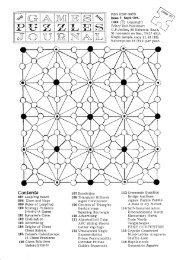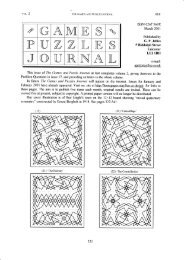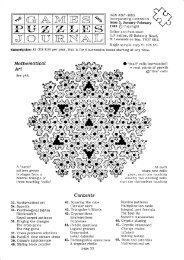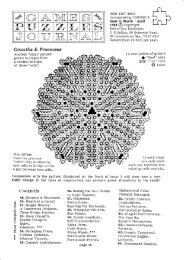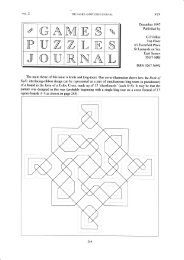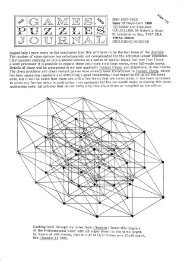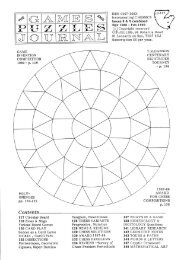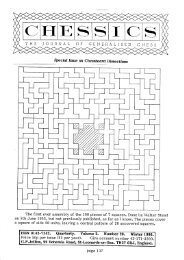The Games and Puzzles Journal, #5+6 - Mayhematics
The Games and Puzzles Journal, #5+6 - Mayhematics
The Games and Puzzles Journal, #5+6 - Mayhematics
Create successful ePaper yourself
Turn your PDF publications into a flip-book with our unique Google optimized e-Paper software.
.&' ^s?<br />
6{v<br />
THE GAMES AND PVZZLES JOURNAL<br />
fufthony Dtclans Memortal TourneY<br />
<strong>The</strong> next issue of <strong>The</strong> Problemist will include an announcement of a composing tourney<br />
in memory of Anthony nEkinqlwho died on 26 November 198?, age ?3. Th-e'toulney will<br />
be for Series Problems of any type on Cylindrical Boards (including the anchor-ring or torus)<br />
<strong>and</strong> will be in two parts: (a) orthodox pieces (b) fairy pieces - not more than two types.<br />
<strong>The</strong> Judge will be Cedric Lytton. Entries, not more than 3 per proposer altogether, should<br />
be sent to me: G.P.JeIliss, 99 Bohemia Road, St Leonards on Sea, East Sussex, TN3? 6RJ.<br />
<strong>The</strong> closing date for entries is 30th September 1989.<br />
ChesscYs<br />
I am well on the way to re-issuing the Chessays series <strong>and</strong> exp<strong>and</strong>ing it with some<br />
further titles. Future titles in the series will be strictly of 16 pages, A5 size, with paper<br />
cover <strong>and</strong> priced at E2 per issue. Production difficulties, <strong>and</strong> cost, have forced me to give<br />
up the card covers <strong>and</strong> larger format that was attempted with No.3. Fuller details will<br />
be announced in the next issue of the <strong>Journal</strong>.<br />
Comments <strong>and</strong> Cottectfons<br />
Ian SHANAHAN prefers a version of my Problem 11 with Ps f4,f6,e7 moved to<br />
h2,g3,h4. This increasei the length to Shm 35 <strong>and</strong> makes all the WPs "structurally nec-<br />
"5iry". I prefer the published version however since it shows the task (of BK circuit<br />
eating all but two of the complete W forces) in pretty (arrow pattern) <strong>and</strong> economical<br />
form iinctuding the number of moves). Not all tasks are Maxima.<br />
Harald GRUBERT corrects 1? by making the piece on c6 a Black Rook, <strong>and</strong> corrects<br />
18 by moving the Black King to d6 <strong>and</strong> the Black Rook to e5'<br />
- stephen TAYLOR comects 34 by moving Black Bishop f4 to g5.<br />
.l.C.oUnaONT (writing some years ago) informed me that Echecs Marseillais was<br />
first published by Albert fortis in 1925 in the Marseilles paper Le Soleil.<br />
Grcsshopryr Chess,es<br />
philip COHEN: Since Grasshoppers are weak they tend to come in swarms; the<br />
G-Chess I've played (described in <strong>Games</strong> magazine in the last year or two) uses 8 each<br />
on the second rank (Pawns go on the third).<br />
Grasshopper combinJd with King: Some alternative examples of shortest games<br />
to mate of one K+c by the other ur" -th" following, dating back to FCCC days: !Q-GPJ'<br />
1K+ccg Sf6 2pf4 Sc6 3pfb Se4+ 4K+Gxh8 mateJU) C.C-.I,.SELLS (now C.C.LYTTON)'<br />
1pe4 K+Ge6 2eh5 ee8 3Sc3 PaG 4Pe5 mate (c) J.D.BEASLEY 1Pa4 K+Gc6 2Ra3 K+Gb6<br />
3Pd3 K+Gxbl 4Qd2 mate. A surprising assortment of different mate positions.<br />
As several correspondents have noted the solution quoted in issue 2 (page 22) rvas<br />
one move-pair too long (presumably this was my first try at it <strong>and</strong> I had forgotten_to-update<br />
my recordi). ttere is anotner solution by C.C.FRANKISS (Brasil): 1Sh3 Sh6 2Sf4 Sfs 3K+Gcg<br />
e6/Sc6 4K+Gxh8 mate, using the S instead of the P to guard the Black Scorpion's escapes.<br />
Caissa's Kaleidoscope<br />
<strong>The</strong>re are some longish stipulations this time - solvers take care! Thanks to the<br />
composers of 66 <strong>and</strong> ?1 for the dedications. In 72: Fers = (1,1) leaper, i.e. single-step Bishop;<br />
(a) is a usual Serieshelpmate in 8, (b) is a Serieshelp-discovered-mate in 21 with 'Royal<br />
Precedence' (i.e. where there is a choice of move order the King goes first - your opinion<br />
as to whether this dual-avoidanee condition'is justified would be valued). ?4 is a zeroposition<br />
- i.e. the diagram is not itself a problem. In 75 'Circe Malefique' means captured men<br />
reappear on the other sidets home squares. In 76 c2 is a White (1,3)R=camelrider, <strong>and</strong> f1<br />
is a Black (1,2)R= Nightrider, One player makes a series of 3 moves, then the other makes<br />
2 moves, the second giving mate. <strong>The</strong> captured men in Antipodean Chess reappear a (4,4)<br />
leap away. In 77-78 the Zebra is a (2,3) leaper, the Bison is a (1,3)+(2,3) leaper. 80 is the<br />
composerrs first problem I. believe.<br />
MORE ORTGTNAL COMPOSITTONS URGENTLY REQUIRED!<br />
All problem compete in an Informal Tourney: Judge 198?-8 Hans GRUBER.<br />
Page ?6




